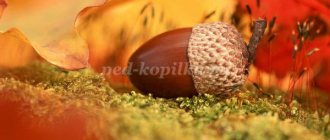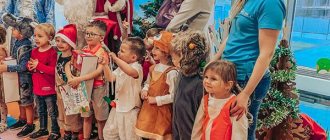In kindergarten, children’s life activities proceed in accordance with a scientifically based regime. It accustoms little pupils to a certain rhythm, promotes the development of useful habits, and protects the child’s nervous system from overwork. A well-written outline of routine moments will help make washing, dressing, walking and eating educational. In the senior group, as in others, the age characteristics of the pupils are taken into account when compiling it.
Daily routine at preschool educational institution
One of the main tasks of the kindergarten is to satisfy all the needs of the body of preschool children, strengthen their health, and also develop useful cultural and hygienic skills. When compiling a summary of routine moments in the senior group, you can rely on the following table.
| Activity | Time frame (according to the “Origins” program) |
| Reception of children, their examination, free games | 7.00 — 8.20 |
| Charger | 8.20 — 8.30 |
| Breakfast | 8.30 — 9.00 |
| Educational activities along with preparation and breaks | 9.00 — 10.30 |
| Walk | 10.30 — 12.20 |
| Returning to the group, undressing | 12.20 — 12.35 |
| Dinner | 12.35 — 13.00 |
| Quiet hour | 13.00 — 15.00 |
| Lifting and hardening | 15.00 — 15.30 |
| Afternoon snack | 15.30 — 15.50 |
| Free games | 15.50 — 17.00 |
| Walk, children go home | 17.00 — 19.00 |
The teacher should encourage the activity and independence of pupils, organizing their activities at scheduled moments. In the older group, children already know how to wash and dress, and eat food carefully. It is necessary to consolidate the achieved results, and also gradually complicate the tasks.
First half of the day in the middle group of preschool educational institutions
A child’s stay in a preschool educational institution can be divided into two stages. The first half of the day is preceded by a quiet hour, after which the second half of the day begins, ending with the children going home.
Finished works on a similar topic
Course work Regime moments of the middle group 420 ₽ Abstract Regime moments of the middle group 230 ₽ Test work Regime moments of the middle group 200 ₽
Receive completed work or specialist advice on your educational project Find out the cost
In the middle group, the following routine moments occur in the first half of the day:
- welcoming children and independent play;
- charger;
- breakfast;
- educational activities;
- walk;
- return to the group;
- dinner;
- daytime nap.
In accordance with the plan of routine moments, in the middle group the day begins with the arrival of children at the preschool educational institution. The teacher’s task is to joyfully welcome children and include them in interesting games with classmates. Some children find it difficult to part with their parents, then they need to be distracted: play out a scene with toys, show a flowering plant, offer to look after it.
In order for the children to finally wake up, get a boost of vigor and activity, they do morning exercises. This regime moment in the middle group provides for the mandatory inclusion of running and walking with different formations, jumping, etc. Usually the lesson is conducted to music.
In the middle group, children already have developed basic self-care skills. They know how to wash their face and arms up to the elbow. The teacher needs to ensure that children do not jostle near the washbasins. Great attention should be paid to accuracy.
The teacher strives to create a calm, friendly atmosphere during routine moments. Pupils in the middle group should not be rushed when they are going for a walk and going to bed. At the same time, they are not allowed to be distracted by games and conversations.
Children are taught the following points:
- be located close to a personal locker;
- remember the order of putting on things, which may be hanging on the wall in the locker room;
- fasten buttons yourself;
- turn clothes right side out;
- put on shoes using a special spoon;
- neatly put things in the locker.
Being on duty in the canteen instills in children a responsible attitude towards assignments and a desire to take care of their comrades. The attendants are dressed in aprons and chef's hats, creating additional motivation for them.
Eating presupposes a positive attitude towards routine moments. In the middle group, before meals, children play quiet games or put away toys. The teacher teaches children the culture of behavior at the dinner table. You can learn these rules with the help of special fairy tales, poems, and acting out stories about an ill-mannered bear who does not know how to eat neatly. Correct behavior is reinforced by praise and encouragement from the teacher.
Setting goals
Before drawing up a summary of the routine issues in the senior group, the teacher should familiarize themselves with the educational program. It indicates what hygiene skills should be developed at this age.
So, when washing, children should act quickly and independently and dry themselves with a personal towel. The habit of washing hands with soap before eating, after visiting the toilet and when dirty is established.
During lunch, children should eat quietly and carefully. They are taught how to properly handle a fork and knife and use a napkin. When sitting at a table, you need to remember about your posture. Coming out from behind him, the children push up their chair and thank the adults, as well as those on duty.
Children should dress and undress quickly, without the help of adults. Things and shoes are neatly put away in a locker in a certain order. The teacher creates in children the need to monitor the cleanliness of their clothes, pay attention to problems in their appearance, and eliminate them.
At the beginning of the school year, children are monitored. The identified “problem areas” are taken into account when organizing activities at critical times. In the older group, children are already familiar with the sequence of actions; a reminder from an adult is enough for them. Praise and encouragement are also actively used.
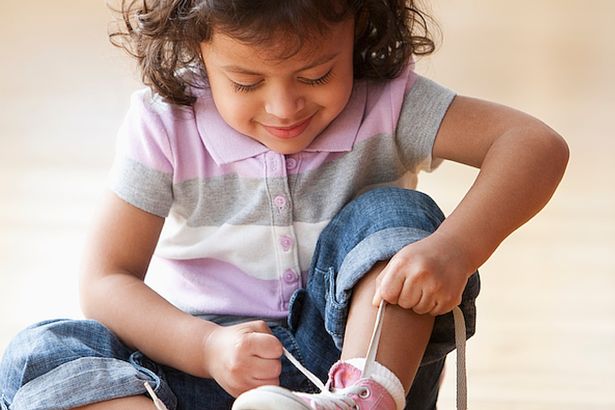
Conducting routine processes in the afternoon for children in the middle group.
I turn on a quiet, quiet melody and make a gradual ascent.After all the children have woken up, I turn on a more energetic and cheerful song and invite the children to do gymnastics after sleep: first stretch into bed, then do a set of gymnastics after sleep. I carry out hardening work: air baths during gymnastics after sleep, walking barefoot, walking barefoot on a massage mat,. I pay attention to the appearance of children. I invite the children to look in the mirror and determine whether their appearance is neat.
I remind the children about the need to comb their hair, I help the girls braid their hair and ponytails. I try to approach every child. I invite the children to look at each other to see if everyone is combed, if everyone is neatly and neatly dressed, after which the children prepare for afternoon tea.
I go to the washroom with the children. . I carry out hardening procedures while washing my hands: I wash my hands up to the elbows with slightly cool water. Do not douse yourself or spray water to wipe your hands dry.
Afternoon snack
After the children have sat down at the table, I wish them a bon appetit and tell them about the benefits of food. When the children are eating, I will make sure that the children sit upright at the table, hold the spoon correctly, do not talk while eating, eat carefully, finish the portion to the end, and use a napkin.
I remind you that you need to thank me for the delicious afternoon snack.
. I invite children to play didactic, board, role-playing games (Shop, Hairdresser, Clinic, etc.) and outdoor games I create conditions for children’s independent motor activity I offer classes based on interests in a book, art or music corner
I provide individual lessons with children.
I spend reading fiction, looking at illustrations and talking about them, listening to music according to the plan.
I ask the children to put their toys back, go to the toilet and go to the locker room. I will make sure that each child goes to their locker. I will clarify with the children the sequence of putting them on. While dressing, I will clarify the children’s knowledge about the seasons: I will ask the children what to wear in summer, autumn, winter, spring. I’ll ask the dressed children to help the others. I will practice tying shoelaces for those who do not know how to do it. I will make sure that the children try to put their clothes neatly in the locker. When everyone is dressed, I will examine the appearance of all the guys. I will discuss with the guys what toys and materials we will take outside. I would say that everyone should go out into the street in an orderly manner, not jostle, the boys should let the girls through and hold the door.
I say goodbye to every child and parent.
Preparation of a summary of routine moments in the senior group
The teacher must plan in advance his actions aimed at developing the necessary self-care skills in children. For this purpose, a summary of the regime moments is drawn up. In the older group, special attention is paid to “problem areas”, as well as children’s conscious attitude towards hygiene procedures.
When planning, the following structure is observed:
- Indication of the topic of the event (“Duty in the dining room”, “Preparing for naps”, “Washing”), as well as the group for which it is designed.
- Target. It is usually defined as strengthening self-care skills during dressing, eating, washing, etc.
- Tasks. They explain how the teacher is going to achieve the goals. Tasks are divided into developmental, educational and educational. The first are aimed at teaching children practical skills (tying shoelaces, using a fork and knife). Educational tasks form the need for order and cleanliness, introduce them to the rules of behavior and polite communication. Educational objectives expand our understanding of the world around us. So, while washing your face, you can have a conversation with your children about germs, and at lunch you can learn more about the profession of a cook.
- Methods. The teacher can use a verbal explanation, visual aids with action algorithms, or a demonstration of a practical skill.
- Equipment. If it happens in the dining room, then it will be dishes, tablecloth, napkins. In the bathroom, this role is played by soap and towel. Sometimes visual aids are used that illustrate the sequence of washing or dressing.
- Progress of the event. All the actions of the teacher, the explanations he gives to the children, poems, riddles, fairy tales, etc. are described in detail here.
Admission of children
This is where the outline of routine moments begins. With children of the older group, the teacher works to solve the following problems:
- Obtaining information about the health status of pupils.
- Creating a good mood.
- Strengthening hygiene skills in children, including a neat appearance and neatness.
- Formation of polite behavior towards peers and adults.
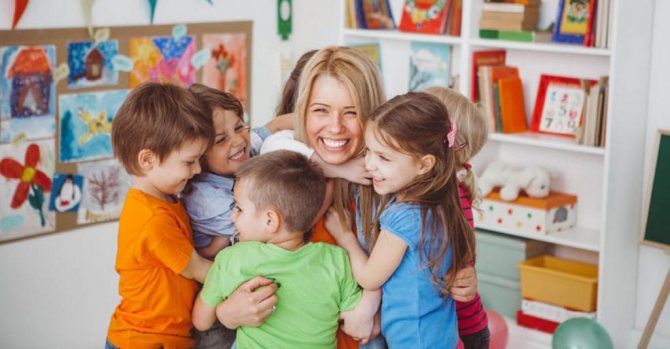
Older preschoolers usually happily run into the group and share news with their friends. Particular attention should be paid to new students, as well as shy children. If the child is in a bad mood, the teacher should distract him with an interesting activity, a work assignment (watering flowers, wiping leaves).
In the summer, pupils meet outside. Children can be offered games with soap bubbles and pinwheels. At this age, it is recommended to conduct psycho-gymnastics, when children stand in a circle, enjoy the morning together, smile at each other, and say kind words.
Washing
In the sixth year of life, children are taught to independently perform hygiene procedures based on an understanding of their benefits and necessity. A summary of the regime moment “Washing” in the senior group may include the following tasks:
- Formation of the need to wash hands after visiting the toilet, if they are dirty and before eating.
- Consolidating knowledge about various hygiene items (comb, soap, toothbrush, towel, etc.)
- Conveying awareness of the importance of personal hygiene.
- Cultivating a positive attitude towards the washing process.
The teacher uses posters with drawings and short captions, poems, and riddles about hygiene items. He makes sure that the children roll up their sleeves, use soap correctly, do not splash water, turn off the tap, dry themselves with individual towels and hang them up. It is better not to use comparisons with other children. It is more useful to notice the personal progress of each student (“Today you yourself remembered that you need to roll up your sleeves”).
Summary of educational activities during restricted periods for children of the 1st junior group
A brief summary of direct teaching activities during the regime for boys of the 1st junior group on the topic:
"Water, water..."
Integration of educational areas:
“Cognition”, “Communication”, “Narrative reading”, “Work”, “Socialization”, “Music”.
Tasks:
Improve your self-washing skills for your hands and face.
Teach children to correctly name hygiene items.
Continue to develop the skill of using a custom towel and comb.
Develop independence and tactile sensations.
Develop cultural and hygiene skills.
Expand your vocabulary: scented soap, towel.
Activate words in children’s speech that denote action: wash, roll up sleeves, lather, wash with soap, comb hair.
Continue teaching your children how to answer the simplest questions.
Methodological techniques:
A game situation showing the teacher, the teacher's actions with the children, the teacher's questions and the children's answers, explanation, showing toiletries, reading children's poems, excerpts of poems, offering children the opportunity to complete words and sentences while reading children's poems and familiar poems.
Preparatory work:
Talking about the purpose of soap, how it happens; studying plot images depicting objects used for washing, using in educational games “Wonderful Bag”, “We will teach Katya to wash”, “Misha visiting Masha”, “Dolls for the bath”. We got acquainted with water, with its property, where it can be found... We learned new sit-down games “We woke up...”, “Washbasin” (a gray rabbit washed his face as a guest...), nursery rhymes, finger games, reading excerpts from a poem by K.I. "Dirty Girl" and other works.
Equipment
: a bag of soap of different colors and shapes, a towel, a comb, a drawing.
Strike:
Children are included in the group.
Educator: Guys, look how many guests we have today. We say hello to them (stand in a circle).
Guys, how beautiful, neat, neat you are. I see you are in a good mood today.”
The teacher invites the children to play a little.
The teacher shows the movements, reads the text of the poem, and the children repeat after the teacher.
Woke up early in the morning (marching in place),
Have a fun, noisy stretch (stand on tiptoes, spread your arms up to the sides);
What else to read: Didactic game for RPPS “Purple Forest”
To make the dream go away, they yawned
The head was slightly shaken (turns left and right. Hands are placed on the shoulders).
Woke us up by running on the spot (running on the spot),
They ran to the bathroom together (they will do the “spring” exercise. Hands on the belt.)
Dressing
Preschoolers are taught to independently monitor their appearance, adjust their collar in a timely manner, tuck their shirt into their trousers, and comb their hair.
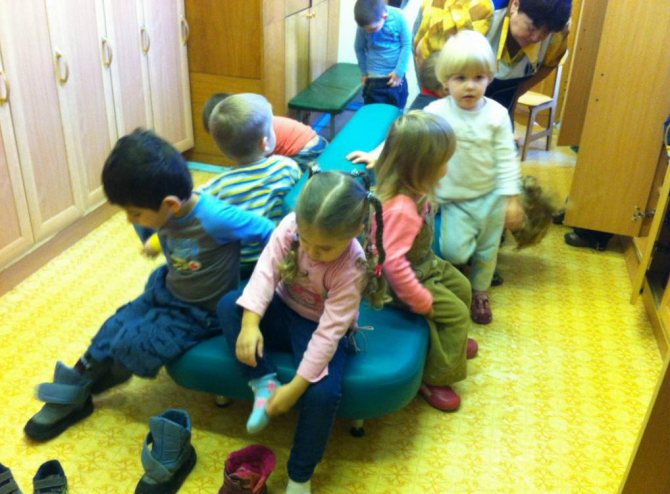
In the summary of the regime moment “Dressing” in the senior group, you can indicate the following tasks:
- Cultivate a caring attitude towards your things and neatness.
- Reinforce the correct dressing algorithm.
- Improve skills in fastening buttons, zippers, and tying shoelaces.
- Repeat the name and purpose of clothing, color, the concepts of “left” and “right”.
Before getting ready for a walk, the teacher and the children tidy up the group and put the toys in their places. Each child gets dressed near their locker. It is important that pupils do not throw their clothes around, carefully fold their things, and put away their spare shoes. In winter, you can hang in a visible place the algorithm for dressing and undressing in pictures. If necessary, individual work is carried out with children, practical techniques are demonstrated on dolls.
Calendar and thematic planning in the second junior group “Safety Week”
Morning
Free activity under the supervision of a teacher.
Goal: to train the ability to ask for toys and exchange them. Develop friendships.
Outdoor Activity: Encourage children to observe indoor plants. Offer to water the plants yourself without climbing on the leaves. To foster a caring attitude towards plants, to consolidate children’s skills and plant care skills.
Morning exercises
– general improvement of the body, development of coordination of movements, training of motor skills.
Game exercise “The doll washes itself” Purpose: to teach children cultural and hygienic skills, pay attention to the sequence of actions, teach children to thoroughly wash their hands and face, explain why they need to dry themselves thoroughly. Develop a careful attitude towards your health.
Conversation “Safety in our group” Goal: consolidate the knowledge of your group, develop the ability to navigate the group’s space, a sense of security and self-preservation; enrich the understanding of the accessible subject world, the purpose of objects, the rules for their safe use; reveal accuracy, respect for group objects.
KHL “Confusion” by K. Chukovsky and nursery rhymes “Tilibom, Tili-bom...”.
Purpose: to give basic ideas for handling matches and hot objects, to clarify how the heroes managed to put out the fire. To cultivate a sense of empathy and joy for the characters of the works.
P / N “Crow and Dog” Purpose: to teach to imitate the movements and voices of birds; learn to move without interfering with each other, increase the craving for physical activity.
Work before bed.
CGN and self-care skills training.
Continue to culturally accustom yourself to behave at the table (eat carefully and independently, chew food well, use a spoon, hold it in your right hand, do not crumble when getting up from the table, push the chair slowly, thanks to the adults.
Learn on your own, take off your clothes before going to bed and fold them neatly on the high chair.
KHL fairy tale “Golden comb rooster”. Goal: to continue learning how to behave in the house when you are suddenly alone, to form the idea that you cannot open the door for anyone.
What else to read: Fun and exciting seated games for kids
Relaxation before bed - listening to folk lullabies. Purpose: to prepare children for bed.
Evening
Health-improving exercises after sleep. Hardening: air baths. Purpose: strengthening immunity and general well-being.
Walk along the “Health” trails. Goal: prevention and correction of flat feet, development of a sense of balance and coordination of movements.
Breathing exercises “Look” Purpose: articulatory breathing training; coordination of hand movements with chest breathing movements.
Consideration of the illustration by Yu. Vasnetsov “Cat House”. Goal: to teach children to carefully examine the illustration, noting the main thing and details in it; develop perception and memory, speech; cultivate a desire to help those in need.
D/I “What kind words do we know?” Goal: to form a culture of communication and a culture of behavior, to continue to teach children to use words expressing a request, gratitude “please”, “thank you”, to teach them to say hello and goodbye, to use the words “see you later” next time.” Cultivate the desire to be an educated child.
Situational conversation “Contacts with strangers” Purpose: To consider and discuss with children the dangerous situations of possible contacts with strangers on the street; Teach your child to behave correctly in such situations. Cultivate a respectful attitude towards yourself.
D / D “What burns, what doesn’t burn” Purpose: to give children an idea of the benefits and dangers of fire. Reinforce your knowledge of what burns and what doesn't. Expand your vocabulary. Develop interest in the game
P/U “Semaphore” Purpose: to strengthen children’s ability to act on a signal; continue to know the designations of traffic lights, consolidate knowledge about colors, cultivate a desire to know the rules of the road.
Research Institute “Tanya the Doll Got a Cold” Goal: to develop independence in choosing roles, develop the ability to use substitute objects, promote the formation of the ability to use a handkerchief, and cultivate a caring attitude towards others.
Autonomous activity in the creativity center: Painting with colors “Car with wheels”. Goal: to teach how to draw rounded lines - wheels, to teach how to hold a brush freely, to draw paint on a brush, to remove excess paint, to increase accuracy in work.
Canteen duty
Setting tables for lunch and cleaning them after meals teaches children to quickly and efficiently carry out important tasks. It is advisable that quick and slow children be paired up, so that they will not return too early from a walk or be late for naptime.
The outline plan for routine moments in the senior group may contain the following tasks:
- Teach children to conscientiously perform their duties.
- Cultivate interest and a positive attitude towards joint work.
- Learn to set the table according to the dishes being served.
- Develop memory and logic.
- Improve communication skills, the ability to negotiate, and act together.
- Learn to evaluate the results of work performed.
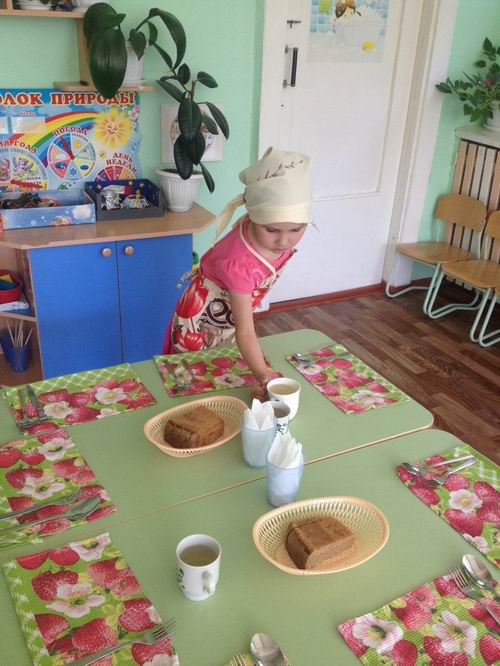
First, those on duty wash their hands and put on aprons and scarves. The teacher tells them the lunch menu. Children independently distribute responsibilities, set tables, lay tablecloths, and arrange cutlery. Invention is encouraged (for example, the idea of using flowers for decorations, unusual ways of folding napkins). The teacher can suggest rational methods for performing this or that action.
After lunch, the attendants sweep up the crumbs, remove empty dishes, bread bins and napkin holders from the tables, and fold the tablecloth. The teacher must evaluate the children’s actions and express gratitude to them for their help.
Eating
When compiling a summary of the “Nutrition” regime in the senior group, the teacher can set himself the following tasks:
- Continue to familiarize yourself with table manners (the ability to use a napkin, cutlery, neatness, chewing food thoroughly with your mouth closed).
- Form healthy habits (correct posture, washing hands before eating).
- Develop fine motor skills.
- Develop a polite attitude towards kindergarten staff and attendants, as well as a habit of cleanliness.
Half an hour before meals, the teacher stops noisy games and invites the children to read a book or do another quiet activity. In small groups, children wash their hands. It is useful to introduce them to the menu, tell them in more detail about the dishes served and the work of the cooks. With the help of fairy tales and poems, you can remind about the rules of behavior at the table.
Meals take place in a friendly atmosphere, without rush. The teacher praises neat kids, monitors the posture of the students, and conducts individual work. If one of the children refuses to eat, it is necessary to find out the reason and calm them down. Sometimes the problem is related to illness, so carefully monitor the condition of such a baby. At the end of lunch, the children wipe their lips with a napkin, thank the staff and those on duty for their work, and move their chairs back. Everyone cleans up their own cup and saucer, rinses their mouth and washes their hands.
Summary of the regime moment “Walk” in the senior group
In preschool institutions, much attention is paid to improving the health of pupils, their physical development, and preventing fatigue. The walk takes place twice a day: after educational classes, and also after afternoon tea. At this time, kids breathe fresh air and play outdoor games. They are allowed to make noise and run freely around the site. The walk may be canceled if there is strong wind, rain or temperatures below -15 °C.
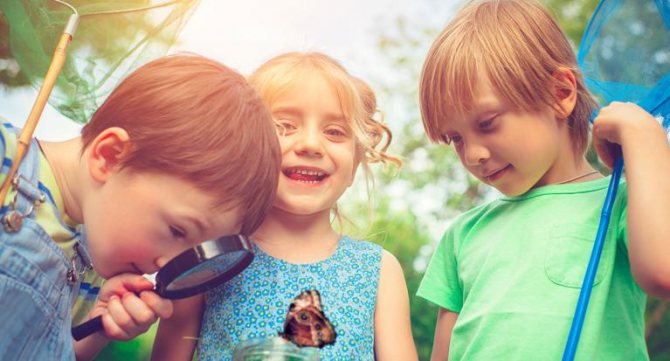
In the older group, the implementation of routine moments is necessarily associated with the time of year and the topics of the educational program. The structure of the walk includes the following elements:
- Observation. It can last from 15 to 25 minutes, is carried out daily and is associated with seasonal changes. Preschoolers observe the work of adults, various natural phenomena, insects and birds, and study plants.
- Outdoor games. The optimal number of them during a walk is 3-4. Older preschoolers love competitions and relay races. They can be introduced to sports games: volleyball, football, hockey, badminton, basketball.
- Work. Children can work with rakes, watering cans and shovels. They are involved in caring for flower beds and vegetable gardens, harvesting autumn leaves, and clearing snow.
- Independent games. Kids can go on an imaginary journey, turn into pilots, pirates or sailors. The teacher creates conditions for the development of story-based and construction games. Sand, pebbles, water or snow can be used as materials.
- Individual work with children to develop lagging skills.
Conducting and self-analysis of the afternoon in the senior group
Nadezhda Batsina
Conducting and self-analysis of the afternoon in the senior group
Conducting and self-analysis of the afternoon routine in the senior group
Gradual rise, awakening gymnastics, air and water procedures 15.00-15.25
I turn on a quiet, quiet melody and make a gradual ascent. After all the children have woken up, I turn on a more energetic and cheerful song and invite the children to do gymnastics after sleep: first stretch into bed, then do a set of gymnastics after sleep. I carry out hardening work: air baths during gymnastics after sleep, walking barefoot, walking barefoot on a massage mat, washing with cool water. I remind you that the bed must be made slowly and carefully. I draw your attention to the fact that (Vanya)
I made my bed the best today.
When a child asks me to help braid his hair, I suggest he comb his hair , and then I help him. I make sure that children do not stand barefoot on the cold floor. I pay attention to the dressing and appearance of children. Having noticed problems, I invite the child to put himself in order and help him with this. I teach children to use a mirror, check their appearance , correct flaws in their suit and hairstyle, developing the habit of always being clean and tidy.
I remind children of the need to comb their hair, help girls braid their hair, and provide an individual approach. I invite the children to look at each other to see if everyone is combed, if everyone is neatly and neatly dressed, after which the children prepare for afternoon tea. Preparation for afternoon tea, afternoon tea 15.25-15.40
I suggest that the children go to the washroom in an orderly manner. I make sure that the children wash their hands thoroughly with soap, do not douse themselves or spray water, that they wipe their hands dry, I provide an individual approach, while the children wash their hands, I ask riddles: I walk, I wander not through the forests, but through my mustache, through my hair. And my teeth are longer than those of wolves and bears (comb)
I appoint people on duty. After all the children have washed their hands, we sit down at the table and wish them a bon appetit. When the children eat, I make sure that the children sit upright at the table, hold the spoon correctly, do not talk while eating, that they eat carefully, finish the portion to the end, use a napkin, and provide an individual approach.
Games, independent activities for children 15.40-15.50
Independent activities of children . I invite children to play didactic, board, role-playing games and outdoor games.
Didactic game “Toy Store”
Goal: develop thinking, promote the development of creative abilities.
I explain the rules of the game. I act as a salesperson. I choose buyers using a counting rhyme. I draw attention to the culture of behavior: that the buyer should greet the seller, say “please”
,
“thank you”
,
“goodbye”
.
I would like to draw your attention to the fact that it is advisable not to repeat toys that were ordered earlier.
Outdoor game “Cat and Mouse”
(OVD – running)
Purpose: to teach how to act in concert with each other.
teach how to navigate in space, create positive emotions The rules of this game are simple: we choose a mouse and a cat among all the players. This is easy to do using lots or counting. For example: One, two, three, four, five. The cat learns to count. Little by little he adds a cat to the mouse. The answer is: There is a cat, but there is no mouse. Now we have the cat, the mouse and the rest of the players. Players hold hands as if shaking hands and form a circle. A mouse runs into a circle. And the cat remains outside the circle. Now let's play! The cat's task is to get into the circle and catch the mouse. The mouse must be agile and dexterous so as not to get caught in the paws of the cat. And everyone else dances in a circle and tries not to let the cat into the circle. The player in the role of a cat can crawl from below under closed hands, jump from above over the hands, or, if possible, try to unhook the hands of the players dancing in a round dance. The children who dance in a circle hold each other's hands tightly, and when the cat tries to get through them, they raise their closed hands down or up, thereby creating a barrier for the cat. Participants in the circle are prohibited from standing shoulder to shoulder! Everything is simple for a mouse! He hides in a circle, runs around, jumps, teases the cat. Maybe even dance a lambada until the cat breaks into the circle. As soon as the cat gets inside the circle, the players open their hands and let the mouse out, and they try to detain the cat using the same methods.
And when the cat breaks out of the circle, she runs after the mouse and, of course, catches up with him! The player in the role of a cat can immediately catch the mouse in the circle if he has time. This depends entirely on the reaction speed of all participants in the game. I create conditions for independent motor activity. I offer classes based on interests.
Labor assignments: I invite the children to help me glue up torn books. Please put the books in their places.
Individual work with children Goal: I continue to teach how to draw trees. Means: A sheet of paper and pencils. I remind Ksyusha and Bogdan how to draw tree trunks and branches, as well as how to draw a spruce. I explain how trees in winter differ from trees in summer.
Preparing for the evening walk, walk 15.50-17.15
I ask the children to put their toys back, go to the toilet and go to the locker room. I clarify with the children the dressing sequence, ask the dressed children to help the others, and make sure that the children try to put their clothes neatly in the locker. When everyone is dressed, I examine the appearance of all the guys. I discuss with the children what toys and materials we will take outside. Before leaving, I draw the children’s attention to the dressing room, in what form we leave it (so that nothing is lying around, all the lockers are closed, I remind them that everyone goes outside in an orderly manner, not jostling, the boys let the girls through and hold the door.
I will organize the children for observation. I ask what new things we learned. After observation, I conduct a didactic game “Tell me what you know about passenger transport”
.
I invite children on their own : active, role-playing. I play an active game with all the children: “Hunters and Hares.” The purpose of the game is to develop children’s ability to run without bumping into each other, to develop dexterity and coordination of children’s movements.
Gathering children for a game: Creating interest among children: Show the children a toy - a hare. - The hare is cowardly, he is afraid of everyone in the forest, and most of all of hunters! Come on, guys, now we’ll play the game “Hunters and Hares”
.Game conditions: On one side of the site there will be a place for hunters (line-skipping rope, and on the other side there are houses of hares
(hoops)
. 2 - 3 hares can live in each house. Rules of the game: Hunters go around the site, pretending to be looking for tracks hares, and then return to their places. When I give a signal to the hares, they run out into the clearing and jump on two legs, moving forward. And as soon as I say:
“Hunters!”
- all the hares run to their houses, and the hunters throw at the hares balls. A hare that was hit by a ball is considered shot and the hunter takes it to his house. The hunter can have 2 - 3 balls in his hands. Consolidation of the rules of the game. Distribution of roles: Using a counting rhyme, select hunters and hares. Placement of players and distribution attributes: Give the hares hats - masks, the hunters - balls sewn from fabric, three each. I monitor the children’s movements and compliance with the rules.
Labor assignment. I suggest that the children put away the play material after the walk.
Children going home
I communicate kindly with parents about how spent the day in kindergarten, about his achievements. I answer parents' questions. If necessary, I give recommendations. I kindly say goodbye to the child and parents.
Self-analysis : I think that I managed to achieve my goals. All regime moments were carried out in accordance with the age and psychological characteristics of children in the older group . The children enjoyed playing the games offered to them, completed tasks, were active, attentive, felt comfortable, received new experiences, and went home in a good mood.
Daytime nap
It takes 2 hours. The outline of the organization of a routine moment in the senior group includes preparation for bed: undressing independently, neatly folding clothes on a high chair, visiting the toilet. The teacher's assistant ventilates the bedroom. Before going to bed, you can read a calm fairy tale to the children or sing a lullaby. Sometimes children fall asleep listening to soft music. The teacher makes sure that the kids lie on their sides and keep their hands on top of the blanket.
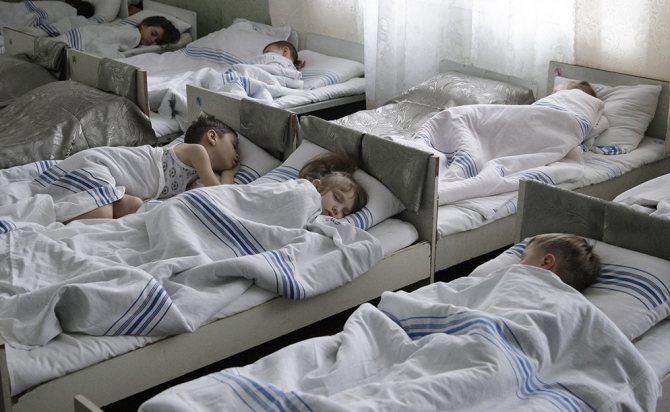
They wake up the boys gradually. They are asked to perform simple exercises right in bed (stretching, arm movements, rotation of the feet). Then the children get up, do slight bends, and march in place. Older preschoolers must make their own bed. After this, hardening is usually carried out: walking on massage mats, rubbing with soft mittens. Under the guidance of a teacher, children can perform acupressure massage of the face, ears, and hands.
A summary of routine moments in the senior group helps the teacher plan his work. Thanks to him, everyday activities turn into developmental ones, which enhances their educational effect.
